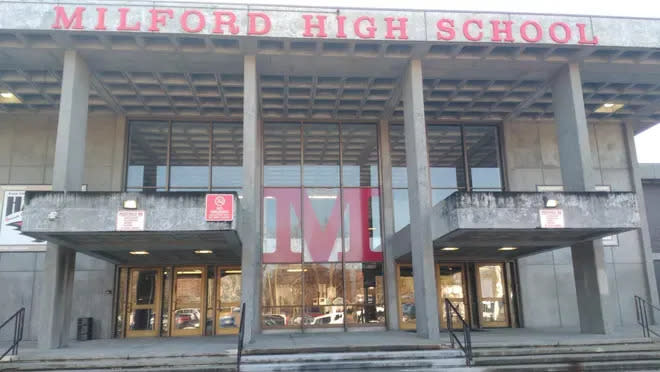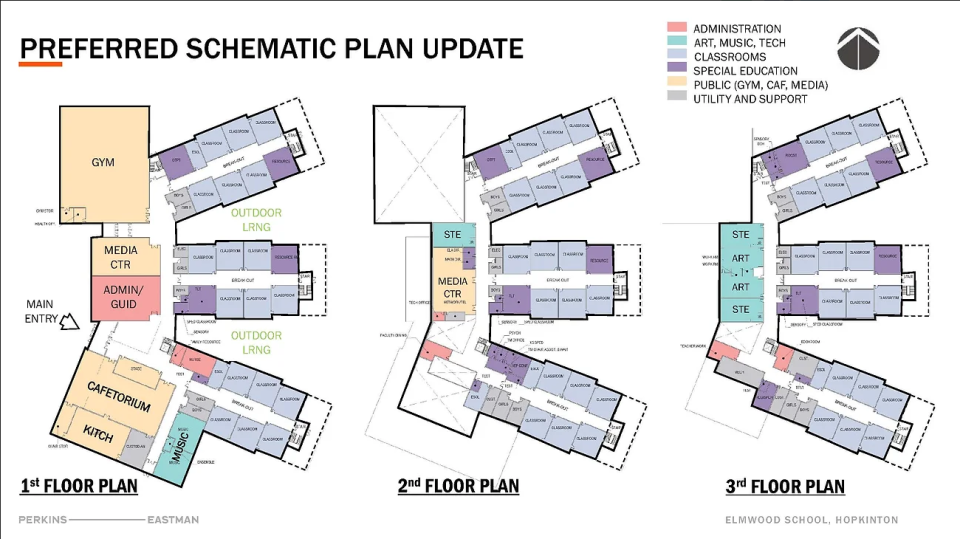Is your school waiting for renovations or a new building? How the MSBA works
With school plans in Framingham, Milford and Northborough accepted into the Massachusetts School Board Authority (MSBA) eligibility pipeline, the three communities have taken a significant step forward in their efforts to make major upgrades to schools.
The three districts and their respective schools — Framingham's Hemenway Elementary School, Milford High School and Northborough's Peaslee Elementary School — were invited into the MSBA's eligibility period. During that 270-day period, beginning Aug. 1, 2024, the state will work with school officials in each community to determine its financial and community readiness to enter the MSBA capital pipeline.
Other proposals, including those for a new Elmwood Elementary School in Hopkinton and a new Tri-County Vocational school project in Franklin, are in later stages of the MSBA process.
And in Ashland, a new David Mindess School opened in September.

For new schools to be constructed, or for existing schools to receive upgrades, communities must complete the following process, outlined on the MSBA website:
Step 1: Eligibility period
The MSBA Board of Directors must vote to invite a school district into the eligibility period based on a review of the district's statement of interest.
Schools in Framingham, Milford and Northborough received their invites after a vote earlier this month.
'Excited to move forward': Milford wins key vote in its goal to rehab — or replace — high school
For this cycle, the eligibility period begins Aug. 1, 2024. For the 270 days after this date, school districts must complete preliminary requirements, including:
A certification of the school district's understanding of the grant program rules by executing an initial compliance certification.
The formation of a school building committee and submitting its members' names to the MSBA for acceptance.
Completing an educational profile questionnaire to further inform the MSBA of the school district's current and proposed educational facilities, teaching methodology, grade configurations and program offerings.
A summary of the school district's existing infrastructure repair practices.
Agree on enrollment estimates for the proposed project with the MSBA, meaning the school district and MSBA will use MSBA methods to efficiently meet space capacity needs throughout future enrollment variations for the new project.
The community is required to vote to authorize spending for the feasibility study in Step 3.
The signing of the MSBA's standard feasibility study agreement, which establishes a process for the school district to be reimbursed for eligible expenses.
School districts that complete preliminary requirements within 270 days are eligible to receive an invitation from the MSBA into its feasibility study phase.
An invitation and completion of eligibility period requirements does not guarantee a spot in the MSBA's capital project pipeline. Districts that do not complete preliminary requirements within the 270 days will have to re-file a statement of interest during the next open filing period.
Step 2: Forming the project team
Once all prerequisites are met to the MSBA's satisfaction, it's time for school districts to form a team to complete the project throughout the MSBA grant process.
The school district then hires an owner's project manager (OPM) and a design team utilizing a specific MSBA procurement process.
The owner's project manager provides project management guidance throughout the life of the public school project, as required by state law. For example, Belmont Public Schools selected Daedalus Projects Inc. for its recent middle and high school project. School districts will also complete standard request-for-services templates and contracts.
Step 3: The feasibility study
Once the team has been successfully formed, the team and the school district collaborate with the MSBA to complete the following:
Document the school's educational programming.
Generate an initial space summary, which documents the spaces needed to deliver the school district's educational programs and services.
Document existing school conditions.
Establish school project design parameters.
Develop and evaluate alternatives to the school project.
Recommend the most cost-effective and educationally appropriate preferred solution to the MSBA Board of Directors for their consideration.
During this phase, a preferred schematic report will be submitted by the project manager on behalf of the district and the project's designer. Approval by the MSBA board of directors is required for all projects to proceed to the next phase.
Step 4: Schematic design
After approval by the MSBA's board of directors, the district, its team and the MSBA will work together to develop a robust schematic design for the proposed project. The schematic design includes detail to establish the scope, budget and schedule for the proposed project.

Step 5: Funding the project
Based on the completed feasibility study, the school district and MSBA staff establish and document the project scope, budget, schedule and MSBA financial participation. This is forwarded to the MSBA Board of Directors for approval.
Approval by the MSBA Board of Directors establishes the MSBA's participation in the project. On the district side, once the community authorizes financial support through a vote, the MSBA and the district enter into a project funding agreement, which defines the scope, budget and schedule for the proposed project.
11 towns act as one: Tri-County communities approve funding for construction of new voke school
The community also must secure local authorization and financial support, such as what happened with the Tri-County and Elmwood School votes. After this, the MSBA and the district enter into a project funding agreement, which defines scope, budget, and schedule for the proposed project.
Step 6: Design development, construction documentation and bidding
During this phase, the district and its team advance the design, generate construction documentation, procure bids, and award a construction contract in accordance with the agreed upon project scope, budget and schedule.
During this phase, the MSBA also continues to monitor the project to ensure it remains on track and meets the expectations of both the district and the MSBA as defined in the funding agreement.
Step 7: Construction administration and project closeout
The MSBA will continue to monitor the progress of the project to confirm that it remains on track and meets the expectations of both the district and the MSBA.
'Buckets catching rainwater': Seven years in the making, Ashland set to christen new Mindess Elementary School
Once the MSBA has reimbursed the district up to 95% of the estimated grant, the MSBA will place remaining payments to the district on hold until the district has submitted all materials required, an audit has been completed and the MSBA Board of Directors has approved the audit.
The final 5% is distributed after the district has accepted the audit report, the closeout forms have been completed and the MSBA has approved the final total grant for the project.
This article originally appeared on MetroWest Daily News: How does the MSBA process for school construction work? An explainer

